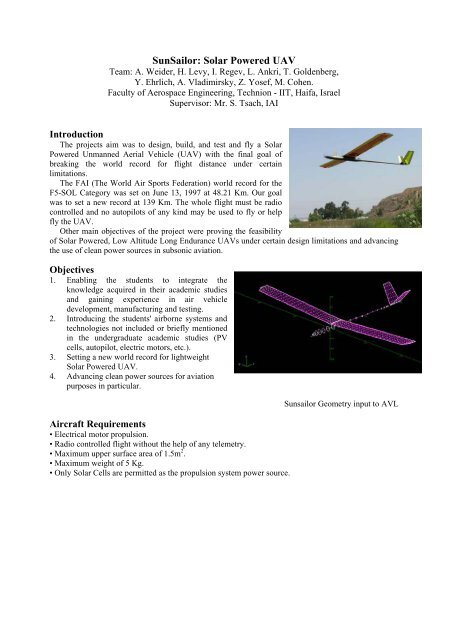SunSailor: Solar Powered UAV - Faculty of Aerospace Engineering
SunSailor: Solar Powered UAV - Faculty of Aerospace Engineering SunSailor: Solar Powered UAV - Faculty of Aerospace Engineering
SunSailor: Solar Powered UAV Team: A. Weider, H. Levy, I. Regev, L. Ankri, T. Goldenberg, Y. Ehrlich, A. Vladimirsky, Z. Yosef, M. Cohen. Faculty of Aerospace Engineering, Technion - IIT, Haifa, Israel Supervisor: Mr. S. Tsach, IAI Introduction The projects aim was to design, build, and test and fly a Solar Powered Unmanned Aerial Vehicle (UAV) with the final goal of breaking the world record for flight distance under certain limitations. The FAI (The World Air Sports Federation) world record for the F5-SOL Category was set on June 13, 1997 at 48.21 Km. Our goal was to set a new record at 139 Km. The whole flight must be radio controlled and no autopilots of any kind may be used to fly or help fly the UAV. Other main objectives of the project were proving the feasibility of Solar Powered, Low Altitude Long Endurance UAVs under certain design limitations and advancing the use of clean power sources in subsonic aviation. Objectives 1. Enabling the students to integrate the knowledge acquired in their academic studies and gaining experience in air vehicle development, manufacturing and testing. 2. Introducing the students' airborne systems and technologies not included or briefly mentioned in the undergraduate academic studies (PV cells, autopilot, electric motors, etc.). 3. Setting a new world record for lightweight Solar Powered UAV. 4. Advancing clean power sources for aviation purposes in particular. Aircraft Requirements • Electrical motor propulsion. • Radio controlled flight without the help of any telemetry. • Maximum upper surface area of 1.5m 2 . • Maximum weight of 5 Kg. • Only Solar Cells are permitted as the propulsion system power source. Sunsailor Geometry input to AVL
<strong>SunSailor</strong>: <strong>Solar</strong> <strong>Powered</strong> <strong>UAV</strong><br />
Team: A. Weider, H. Levy, I. Regev, L. Ankri, T. Goldenberg,<br />
Y. Ehrlich, A. Vladimirsky, Z. Yosef, M. Cohen.<br />
<strong>Faculty</strong> <strong>of</strong> <strong>Aerospace</strong> <strong>Engineering</strong>, Technion - IIT, Haifa, Israel<br />
Supervisor: Mr. S. Tsach, IAI<br />
Introduction<br />
The projects aim was to design, build, and test and fly a <strong>Solar</strong><br />
<strong>Powered</strong> Unmanned Aerial Vehicle (<strong>UAV</strong>) with the final goal <strong>of</strong><br />
breaking the world record for flight distance under certain<br />
limitations.<br />
The FAI (The World Air Sports Federation) world record for the<br />
F5-SOL Category was set on June 13, 1997 at 48.21 Km. Our goal<br />
was to set a new record at 139 Km. The whole flight must be radio<br />
controlled and no autopilots <strong>of</strong> any kind may be used to fly or help<br />
fly the <strong>UAV</strong>.<br />
Other main objectives <strong>of</strong> the project were proving the feasibility<br />
<strong>of</strong> <strong>Solar</strong> <strong>Powered</strong>, Low Altitude Long Endurance <strong>UAV</strong>s under certain design limitations and advancing<br />
the use <strong>of</strong> clean power sources in subsonic aviation.<br />
Objectives<br />
1. Enabling the students to integrate the<br />
knowledge acquired in their academic studies<br />
and gaining experience in air vehicle<br />
development, manufacturing and testing.<br />
2. Introducing the students' airborne systems and<br />
technologies not included or briefly mentioned<br />
in the undergraduate academic studies (PV<br />
cells, autopilot, electric motors, etc.).<br />
3. Setting a new world record for lightweight<br />
<strong>Solar</strong> <strong>Powered</strong> <strong>UAV</strong>.<br />
4. Advancing clean power sources for aviation<br />
purposes in particular.<br />
Aircraft Requirements<br />
• Electrical motor propulsion.<br />
• Radio controlled flight without the help <strong>of</strong> any telemetry.<br />
• Maximum upper surface area <strong>of</strong> 1.5m 2 .<br />
• Maximum weight <strong>of</strong> 5 Kg.<br />
• Only <strong>Solar</strong> Cells are permitted as the propulsion system power source.<br />
Sunsailor Geometry input to AVL
2<br />
2<br />
Aircraft Definition (for Sunsailor1)<br />
Max T.O Weight: 3.6[Kg] Length: 2.2[m] Wing Airfoil: SD7032<br />
Span: 4.2[m] Wing Area: 1.35[m 2 ] Aspect Ratio: 13.15<br />
Wing Dihedral: 3.5◦ Tail Airfoil: NACA0007 Horizontal Tail AR: 5.77<br />
Tail Aperture: 90◦ Electric Motor: Hacker B50-13S Speed Controller: Hacker X30<br />
Gear Ratio: 6.7:1 Propeller: 15”x10” <strong>Solar</strong> Array (Sunsailor1/2)<br />
PV’s Area: 0.943/1.097[m 2 ] PV’s Efficiency: 21% PV’s Weight: 0.66/0.77[Kg]<br />
PV’s Maximum Power: 100/140[W]<br />
Performance<br />
The basic flying qualities could be tested during flight using telemetry data and are presented here for<br />
both design and tested values:<br />
Quality Designed/Tested<br />
Stall Airspeed: 12/13 [knots]<br />
Max. Airspeed: 33/38 [knots]<br />
Cruise Airspeed: 25/23 [knots]<br />
Max. Climb Rate: 300/240 [ft/min]<br />
<strong>Solar</strong> Array Power required for take<strong>of</strong>f: 50/70 [Watt]<br />
Wing Max. Load Factor: 2.8/4<br />
Movies<br />
Building Sunsailor http://ae-www.technion.ac.il/courses/building_sunsailor.mpg<br />
Flying Sunsailor http://ae-www.technion.ac.il/courses/sunsailor_flight.mpg



